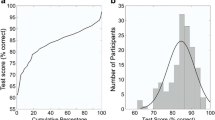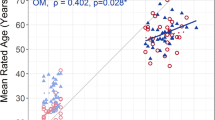Abstract
Voice recognition was assessed by a matching to sample procedure in 30 right-handed adults with normal hearing. The subject was required to indicate which of three voices speaking a nonsense syllable matched the speaker of a sample vowel. Subjects were able to recognize voices with reasonable accuracy, but there were no significant differences as a function of ears or practice, and performance was not markedly affected by knowledge of results or mode of response. There was a significant difference as a function of the temporal position of the matching voice, with recognition being most accurate when the matching voice was first and least accurate when it was third. Further research is necessary to determine whether voice recognition should be classified as the type of verbal ability associated with the cerebral hemisphere dominant for speech, or whether it is the type of nonverbal auditory ability associated with the nonspeech hemisphere.
Similar content being viewed by others
References
Benton, A. L., and Van Allen, M. W. (1968). Impairment in facial recognition in patients with cerebral disease.Trans. Amer. Neurol. Assoc. 93: 38–42.
Beyn, E. S., and Knyazeva, G. R. (1962). The problem of prosopagnosia.J. Neurol., Neurosurg., Psychiatry 25: 154–163.
Bornstein, B., and Kidson, D. (1959). Prosopagnosia.J. Neurol., Neurosurg., Psychiatry 22: 124–131.
Bricker, P. D. and Pruzansky, S. (1966). Effects of stimulus content and duration on talker identification.J. Acoust. Soc. Amer. 40: 1441–1449.
Clarke, F. R. (1965). Speaker recognition by humans,J. Acoust. Soc. Amer. 37: 1211.
De Renzi, E., Scotti, G., and Spinnler, H. (1969). Perceptual and associative disorders of visual recognition.Neurology 19: 634–642.
Doehring, D. G. (1970). Temporal sequence effects in frequency and intensity discrimination by oddity, matching to sample, and ABX. Unpublished manuscript.
Doehring, D. G., Dudley, J. G., and Coderre, L. (1967). Programmed instruction in picture-sound association for the aphasic.Folia Phoniatrica 19: 414–426.
Friedlander, B. Z. (1968). The effect of speaker identity, voice inflection, vocabulary, and message redundancy on infants' selection of vocal reinforcement.J. Exp. Child Psychol. 6: 443–459.
Grenier, D. (1969). La prosopagnosie et l'agnosie des voix. Unpublished M.A. thesis, Universite de Montreal.
Hécaen, H., and Angelergues, R. (1962). Agnosia for faces (prosopagnosia).Arch. Neurology 7: 92–100.
Kersta, L. G. (1962). Voiceprint identification,Nature 196: 1253–1257.
Kimura, D. (1963). Right temporal-lobe damage.Arch. Neurology 8: 264–271.
Kimura, D. (1967). Functional asymmetry of the brain in dichotic listening.Cortex 3: 163–178.
Konorski, J. (1967).Integrative Activity of the Brain. University of Chicago Press, Chicago, pp. 128–131.
Liberman, A. M., Cooper, F. S., Shankweiler, D. P., and Studdert-Kennedy, M. (1967). Perception of the speech code.Psychol. Rev. 74: 431–461.
Luck, J. E. (1969). Automatic speaker verification using cepstral measurements.J. Acoust. Soc. Amer. 46: 1026–1032.
Milner, B. (1962). Laterality effects in audition. In Mountcastle, V. B. (ed.),Interhemispheric Relations and Cerebral Dominance, Johns Hopkins Press, Baltimore, Md.
Pollack, I., Pickett, J. M., and Sumby, W. H. (1954). On the identification of speakers by voice.J. Acoust. Soc. Amer. 26: 403–406.
Shankweiler, D. P., and Studdert-Kennedy, M. (1967). Identification of consonants and vowels presented to left and right ears.Quart. J. Exper. Psychol. 19: 59–63.
Solzhenitsyn, A. I. (1968).The First Circle. Harper & Row, New York.
Spinnler, H. and Vignolo, L. A. (1966). Impaired recognition of meaningful sounds in aphasia.Cortex 2: 337–348.
Stevens, K. N., Williams, C. E., Carbonell, J. R. and Woods, B. (1968). Speaker authentication and verification: A comparison of spectrographic and auditory presentations of speech material.J. Acoust. Soc. Amer. 44: 1596–1607.
Swisher, L. P., Dudley, J. G. and Doehring, D. G. (1969). The influence of contralateral noise on auditory intensity discrimination.J. Acous. Soc. Amer. 45: 1532–1536.
Voiers, W. D. (1964). Perceptual basis of speaker identity.J. Acoust. Soc. Amer. 36: 1065–1073.
Warrington, E. K., and James, M. (1967). An experimental investigation of facial recognition in patients with unilateral cerebral lesions.Cortex 3: 317–326.
Author information
Authors and Affiliations
Additional information
This research was supported in part by grant MA-1652 from the Medical Research Council of Canada.
Rights and permissions
About this article
Cite this article
Doehring, D.G., Ross, R.W. Voice recognition by matching to sample. J Psycholinguist Res 1, 233–242 (1972). https://doi.org/10.1007/BF01074439
Received:
Issue Date:
DOI: https://doi.org/10.1007/BF01074439




